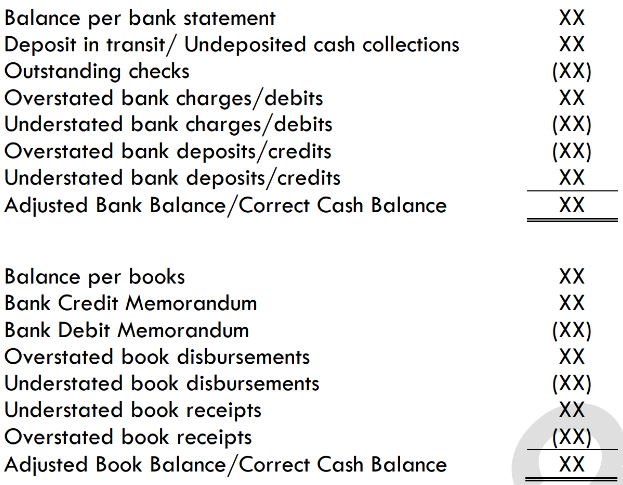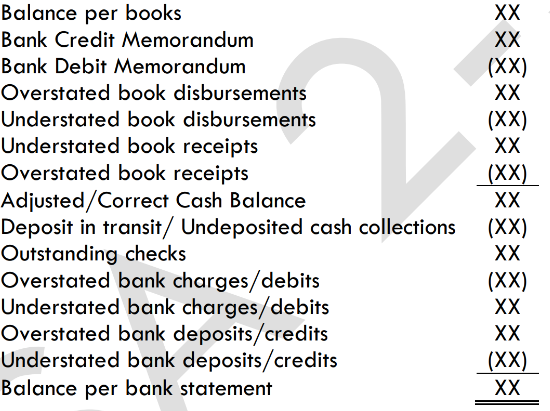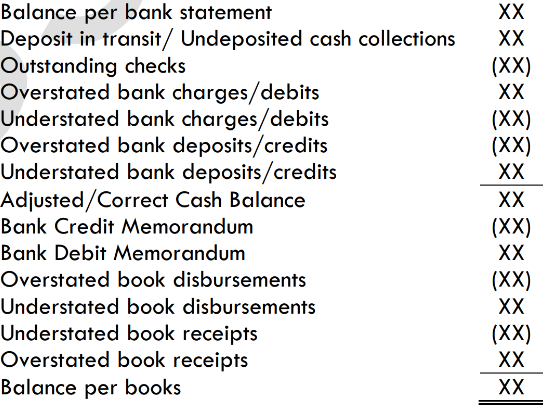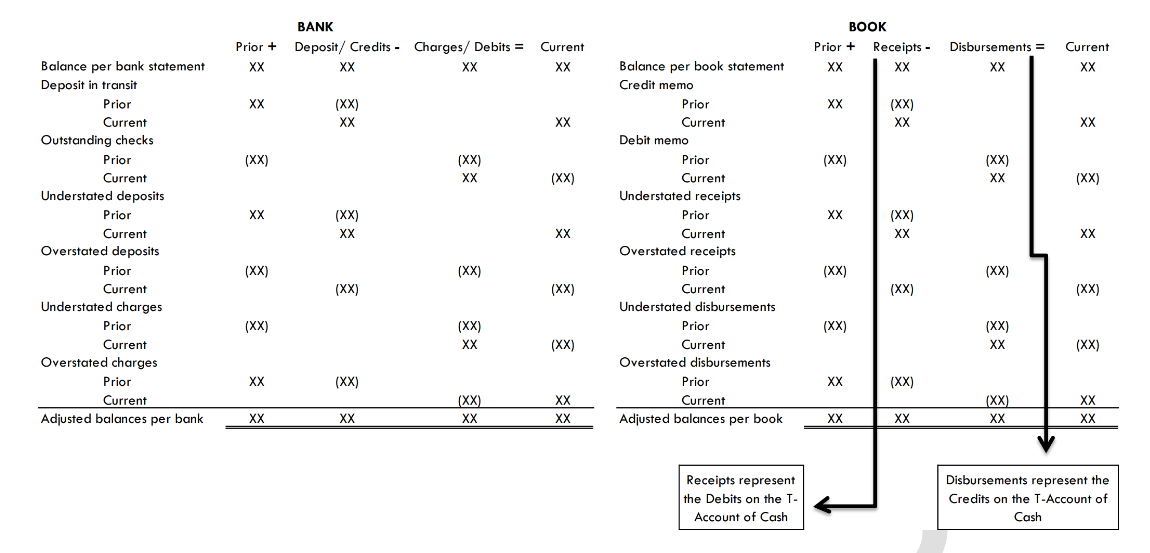01 Cash and Cash Equivalents
1/61
There's no tags or description
Looks like no tags are added yet.
Name | Mastery | Learn | Test | Matching | Spaced |
|---|
No study sessions yet.
62 Terms
Cash
Includes money and any other negotiable instruments that is payable in money and accepted by banks for deposit and immediate credit. This is the most liquid asset.
Cash on Hand
Coins and Currencies
Checks
(X) Undelivered & Post-dated drawn by another person or entity
(X) Stale check drawn by another person or entity
Money Order
Bank Drafts
Cash in Bank
Demand Deposit
Savings Deposit
Unrestricted / Informal Compensating Balance
Bank Overdraft
Immaterial
2 or more accounts with the same bank
Cash Fund
Current Asset Acquisition
For Use in Operations
Settlement of Current Liabilities
Petty Cash Fund
A small amount of cash kept on hand to pay for small, infrequent expenses.
Check
A bill of exchange drawn on a bank payable on demand. It is a written order to the bank by the depositor to pay a specified sum of money to a designated person
Purposes of Bank Reconciliation
❖ It explains the difference between the balances reported by the company and by the bank on a given date
❖ It proves the accuracy of both the company’s and the bank’s records, and reveals any errors made by either party.
❖ It can help detect attempts at theft and manipulation of records.
❖ It establishes the adjusted ending cash balance and provide information to be used for the adjusting entries.
Deposit in Transit
Cash receipts already recorded in the cash receipts journal that reached the bank to late to be credited in the bank statement.
Outstanding Checks
Checks that have been written and recorded by the company but have not yet cleared or paid by the bank.
Credit Memorandum
The collection of receivables made by the bank on behalf of the companyresulting in an increase in the company's bank account balance. This may include amounts collected from customers or notes receivable.
Debit Memorandum
A document issued by the bank to inform the company of deductions from its account, such as service fees or returned checks.
Bank Reconciliation: Adjusted Balance Method

Bank Reconciliation: Book to Bank Method

Bank Reconciliation: Bank to Book Method

Proof of Cash
A four-column bank reconciliation is essentially a roll forward of each line item in a bank reconciliation form one accounting period to the next, incorporating separate columns for cash receipts and cash disbursements.
Proof of Cash
The most powerful tool to identify the fraudulent technique known as kiting.
Proof of Cash Pro-Forma

d. Existence
Which of the following balance-related audit objective typically is assessed as having high inherent risk for cash?
a. Cut-off
b. Detail tie-in
c. Presentation and disclosure
d. Existence
d. Even when the ending balance is immaterial.
The general cash account is considered a significant account in almost all audits:
a. Except those of not-for-profit organizations.
b. Where either the beginning or ending balance is material.
c. Where the ending balance is material.
d. Even when the ending balance is immaterial.
d. Monthly interest payment
An imprest petty cash fund would least likely be used to pay for which of the following items?
a. Minor office expenses
b. Postage stamps for mailings
c. Small contributions to a birthday event
d. Monthly interest payment
d. Cash will be overstated, and expense understated.
What is the effect of not replenishing the petty cash fund at year-end and not making the appropriate adjusting entry?
a. A detailed audit is necessary.
b. Expenses will be overstated, and cash will be understated.
c. The petty cash custodian should turn over the petty cash to the general ledger.
d. Cash will be overstated, and expense understated.
d. A bank reconciliation from the client.
The starting point for the verification of the balance in the general bank account is to obtain:
a. A cutoff bank statement directly from the bank.
b. The client’s cash account from the general ledger.
c. The client’s year-end bank statement.
d. A bank reconciliation from the client.
d. Confirm directly with bank.
Which of the following substantive audit procedures is most likely to be performed by the auditor to gather evidence in support of the balance per bank?
a. Compare to general ledger.
b. Trace items on the cutoff bank statement to bank reconciliation.
c. Trace to cash receipts journal.
d. Confirm directly with bank.
d. Inspect bank credit memo.
Which of the following substantive audit procedures is least likely to be performed by the auditor to gather evidence in support of the deposits in transit?
a. Inspect supporting documents for reconciling item not appearing on cutoff bank statement.
b. Trace items on the bank reconciliation to cutoff bank statement.
c. Trace to cash receipts journal.
d. Inspect bank credit memo.
d. Confirm directly with bank.
Which of the following substantive audit procedures is least likely to be performed by the auditor to gather evidence in support of the outstanding checks?
a. Ascertain reason for unusual delay.
b. Trace items on the bank reconciliation to cutoff bank statement.
c. Trace to cash disbursements journal.
d. Confirm directly with bank.
d. A cutoff bank statement.
A partial-period bank statement and the related canceled checks, duplicate deposit slips, and other documents included in bank statements, mailed by the bank directly to the CPA firm's office, is called:
a. A four-column proof of cash.
b. A short-period bank statement.
c. A year-end bank statement.
d. A cutoff bank statement.
d. Verify reconciling items on the client’s bank reconciliation.
An auditor who is engaged to examine the financial statements of a business enterprise will request cutoff bank statement primarily in order to:
a. Detect kiting.
b. Detect lapping.
c. Verify the cash balance reported on the bank confirmation inquiry form.
d. Verify reconciling items on the client’s bank reconciliation.
d. Corroborate information regarding deposit and loan balances.
The primary purpose of sending a standard confirmation request to financial institutions with which the client has done business during the year is to:
a. Detect kiting activities that may otherwise not be discovered.
b. Provide the data necessary to prepare a proof of cash. c
. Request information about contingent liabilities and secured transactions.
d. Corroborate information regarding deposit and loan balances.
d. The confirmation form also seeks information about indebtedness to the bank.
The auditor should ordinarily mail confirmation requests to all banks with which the client has conducted any business during the year, regardless of the year-end balance, since:
a. The mailing of confirmation forms to all such banks is required by GAAS.
b. This procedure relieves the auditor of any responsibility with respect to non-detection of forged checks.
c. This procedure will detect kiting activities which otherwise not be detected.
d. The confirmation form also seeks information about indebtedness to the bank.
d. Material control weaknesses in cash receipts and cash disbursements.
Auditors are likely to prepare a proof of cash when the client has:
a. Material control weaknesses in accounts payable and inventory.
b. Material control weaknesses in accounts receivable and revenue.
c. Material control weaknesses in payroll.
d. Material control weaknesses in cash receipts and cash disbursements.
d. A substantive test of transactions and test of details of balances.
A proof of cash represents:
a. A substantive test of transactions.
b. A test of controls and substantive test of transactions.
c. A test of details of balances.
d. A substantive test of transactions and test of details of balances.
c. Internal substantiating evidence are adequate.
We use the positive confirmation template in the following situations except for:
a. Individual account balances are relatively large.
b. There is reason to believe that there may be a substantial number of accounts in dispute or with inaccuracies or irregularities.
c. Internal substantiating evidence are adequate.
d. Internal control system is weak.
d. Presentation and disclosure
Review of credit balances and unusual items for accounts receivable is being performed to test what assertion?
a. Existence
b. Rights and obligations
c. Completeness
d. Presentation and disclosure
b. Other reliable external evidence to support the balances is likely to be available.
Auditors may choose not to confirm accounts payable because:
a. The balances due will have changed between the year-end and the date of confirmation.
b. Other reliable external evidence to support the balances is likely to be available.
c. Confirmation obtains evidence identical to that obtained by cutoff tests.
d. A reading of the corporate minutes reveals that confirmation is unnecessary.
c. Reviewing interbank transfers near the reporting date
Which audit procedure is performed specifically to detect and correct kiting?
a. Bank confirmations
b. Testing cash valuation
c. Reviewing interbank transfers near the reporting date
d. Journal entry testing
b. Validates samples of both bank and book reconciling items based on the testing thresholds as documented in the audit plan.
In reviewing client’s bank reconciliation schedules, the auditor ordinarily
a. Validates all bank and book reconciling items.
b. Validates samples of both bank and book reconciling items based on the testing thresholds as documented in the audit plan.
c. Validates all book reconciling items. After all, only book reconciling items such as collections made by the bank in behalf of the depositor, interest income, and bank charges require adjusting entries in the books.
d. Validates samples of book reconciling items based on the testing thresholds as documented in the audit plan. After all, only book reconciling items such as collections made by the bank in behalf of the depositor, interest income, and bank charges require adjusting entries in the books.
Cash funds that are intended for settlement of long-term obligations in the future qualify to be reported as part of the current assets.
Which of the following statements relating to cash is INCORRECT?
The presentation of the cash item must parallel the intention of the management for which cash is held.
Cash funds that are intended for settlement of long-term obligations in the future qualify to be reported as part of the current assets.
Cash deposits with banks that have been restricted because of an unforeseen circumstance are excluded from cash.
Working funds segregated for current use in the ordinary conduct of business, such as petty cash fund and change fund, qualify as cash under current assets.
Not-sufficient fund checks
Which of the following would NOT be classified as cash?
Cashier's checks
Not-sufficient fund checks
Personal checks
Traveler's checks
errors made by the company
Bank statements provide information about all of the following, EXCEPT
bank charges for the period
checks cleared during the period
errors made by the company
not-sufficient funds check
cash reserved for acquisition of property, plant and equipment within 3 months from the reporting date
Cash and cash equivalents on the statement of financial position EXCLUDE
cash reserved for acquisition of property, plant and equipment within 3 months from the reporting date
checks drawn before the reporting date but held for later delivery to creditors
unrestricted 30-day time deposits
US dollars deposited in foreign currency depository account
if legally restricted and held against short-term credit should not be included in the cash balance but is reported among current assets
Deposits held as compensating balances
if legally restricted and held against long-term credit may be included among current assets
if legally restricted and held against short term credit may be included as cash
if legally restricted and held against short-term credit should not be included in the cash balance but is reported among current assets
usually do not earn interest
preparing regular bank reconciliation
A good internal control system provides for
allowing one person to receive cash and to record cash receipts
delaying the deposit of cash collections because no one knows for sure the account to be credited
making payments from the day's collections
preparing regular bank reconciliation
I, II and III
Which of the following are characteristics of an effective control of cash disbursements?
I. Requiring all checks to be pre-numbered
II. Requiring all checks to be signed by one person and countersigned by another
III. Requiring approved supporting documents for each check issued
IV. Requiring disbursements to be done in cash from daily receipts prior to making bank deposits to minimize handling of cash
I, II and III
I, III and IV
I and II
II, III and IV
a reconciliation of the cash receipts and payments during the current period together with the beginning and ending balances of cash
A proof of cash is
a proof of a company's liquid position
a proof of the existence of a cash deposit in a bank
a reconciliation of the cash receipts and payments during the current period together with the beginning and ending balances of cash
a reconciliation of the cash receipts and payments during the previous period, together with the beginning and ending balances of cash
unrestricted and available for use in current operations.
For an item to be reported as cash and cash equivalents, it must be
unrestricted and available for use in current operations.
available only for the purchase of property, plant and equipment
set aside for the liquidation of long-term debt.
deposited in bank and restricted by the court exclusively for payment of back wages of employees who won in a court case against the employer company.
debited when the petty cash fund proves out short
A cash short and over account is
a contra account to cash
debited when the petty cash fund proves out over
debited when the petty cash fund proves out short
not generally accepted
pay small and immediate miscellaneous expenses
A petty cash system is designed to
encash checks of selected employees.
handle cash sales.
account for all cash receipts and payments of minimal amounts.
pay small and immediate miscellaneous expenses
to avoid the overstatement of cash and the understatement of expenses.
A petty cash fund is reimbursed just prior to the end of the reporting period and an adjusting entry is made
to avoid the overstatement of cash and the understatement of expenses.
to avoid the understatement of cash and the overstatement of expenses.
to conceal shortages in cash.
to avoid the misstatement of sales
Inventories
Which of the following is NOT a financial asset?
Cash and cash equivalents
Investment in equity shares of other entities
Trade receivables, loans and other receivables
Inventories
may include a debit to miscellaneous expense for bank service charges.
The journal entries for a bank reconciliation
are taken from the balance per bank section only.
may include a credit to accounts receivable for an NSF check
may include a debit to accounts payable for an NSF check.
may include a debit to miscellaneous expense for bank service charges.
A past-due promissory note in favor of ABC Company by its president
As of December 31, 2020, ABC Company had various checks and papers in its safe. Which item should NOT be included in its cash account in its statement of financial position?
A past-due promissory note in favor of ABC Company by its president
ABC Company's December 28, 2020, P50,000 check payable to NSR Company, an ABC Company's supplier
XYZ Company's check dated December 5, 2020, P15,000 check payable to ABC Company
US$15,000 cash
II, III and IV
Which of the following are basic characteristics of a system of cash control?
I. Combined responsibility for handling and recording cash
II. Daily deposit of all cash received
III. Internal audit at irregular intervals
IV. Use of a voucher system
I, II and III
II, III and IV
I, III and IV
II and III
I, V and VI
Bank reconciliations are normally prepared on a monthly basis to identify adjustments needed in the depositor's records and to identify bank errors. Adjustments should be recorded for the following:
I. Book errors
II. Outstanding checks
III.Deposits in transit
IV. Bank errors
V. Debit memos
VI. Credit memos
II, III and IV
I, V and VI
I, II and III
II, III and IV
time-lapse differences
Seldom does the balance of the cash in bank account in the depositor's books agree with the balance appearing in the bank statement at a particular date because of
a tax avoidance
bank secrecy requirements
negligence by the bookkeeper
time-lapse differences
II, V and VI
The following are reconciling items in an enterprise's bank reconciliation statement.
I. Deposit in transit
II. Company check for P32,500 recorded in the books for P23,500
III. Check of another company erroneously charged by bank in the company's account
IV. Deposit of another company erroneously credited by bank to the company's account
V. Bank service charges
VI. No sufficient fund check charged back by the bank
VII. Company deposit for P32,500 recorded in the books for P23,500
Which of the foregoing adjustments would be shown as deduction from the cash balance per books in order to arrive at the correct cash balance?
II, IV, V, VI and VII
II, V, VI and VII
II, V and VI
V, VI and VII
Post dated checks payable to the company
Which of the following items would normally be EXCLUDED from the amount to be reported as cash on a company's statement of financial position?
Petty cash fund
Post-dated checks issued by the company
Post dated checks payable to the company
Undelivered checks written and signed by the company
Prove the correctness of the cash balance in the client's year-end balance sheet.
A proof of cash is used by a CPA to
Comply with Philippine Auditing Practice Statements.
Determine if there were any unauthorized disbursements or unrecorded deposits during the reconciliation period.
Prove that the client's bank did not make an error during the period under examination.
Prove the correctness of the cash balance in the client's year-end balance sheet.
Customer’s postdated checks
Which of the following would not be classified as cash?
Personal checks
Customer’s postdated checks
Cashiers' checks
Travelers' checks
It establishes the adjusted ending cash balance and provide information to be used for the closing entries.
Which of the following is not a purpose of bank reconciliation?
It establishes the adjusted ending cash balance and provide information to be used for the closing entries.
It proves the accuracy of both the company’s and the bank’s records, and reveals any errors made by either party.
It can help detect attempts at theft and manipulation of records.
It explains the difference between the balances reported by the company and by the bank on a given date
The Petty Cash account is debited when the fund is replenished.
Which of the following is not true?
The imprest petty cash system in effect adheres to the rule of disbursement by check.
Entries are made to the Petty Cash account only to increase or decrease the size of the fund or to adjust the balance if not replenished at year-end.
The Petty Cash account is debited when the fund is replenished.
All of these answer choices are not true
The reimbursement of the petty cash fund should be credited to the cash account.
When a petty cash fund is used, which of the following is true?
The petty cashier's summary of petty cash payments serves as a journal entry that is posted to the appropriate general ledger account.
The balance of the petty cash fund should be reported in the statement of financial position as a long-term investment.
The reimbursement of the petty cash fund should be credited to the cash account.
Entries that include a credit to the cash account should be recorded at the time the payments from the petty cash fund are made
I, II, IV, V, VII
Which of the following are considered cash for financial reporting purposes?
I. Petty cash funds and change funds
II. Money orders, travelers' checks, and personal checks
III. Postdated checks and IOUs
IV. Coins, currencies and funds for current operations
V. Savings account for employees’ travel
VI. Savings account for acquisition of equipment
VII. Savings account for acquisition of inventories
I, II, III, IV, VII
I, II, III, IV, V, VII
I, II, IV, V, VI, VII
I, II, IV, V, VII